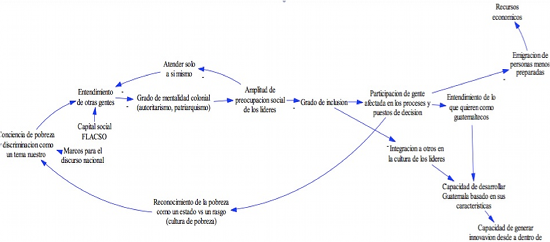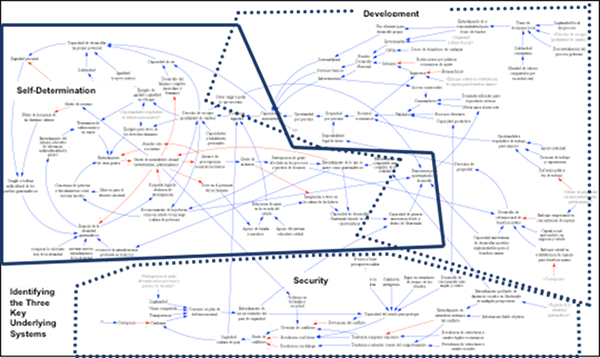Systems Logic Mapping
- Objective: To demystify the persistence of poverty in its context
- Materials/Preparation: Large paper, A4 or letter sized paper, colored pens, colored markers.
- Participants: CARE Staff and Partners
- Key Informants: Key stakeholders (military, academic, government, NGO, civil society representatives private sector) related to the issue studied
Steps
- Phase 1: Introduce the topic and brainstorm factors relating to the central concept
- Phase 2: Map each of these factors
- Phase 3: Develop cross-map connections: how do factors relate or connect to one another? Develop a system for marking level of influence (major or minor) and whether influences are positive, negative or neutral.
- Phase 4: Integrate diverse perspectives into the map, as needed
- Phase 5: Analyze the map, identify key variables influencing the central question, and predict its future evolution
Examples
CARE Guatemala undertook a months-long reflection on systems logic mapping in partnership with the Institute for Strategic Clarity as part of its Women’s Empowerment Strategic Impact Inquiry:
Phase 1: Introduce the topic and brainstorm factors relating to the central concept
Initially the team worked together to reflect on and understand their own aspirations for the country to develop a collective understanding of Guatemala’s experience over time mapped a chart of trends over the past twenty years as well as developed a projection of the countries progression over the next twenty years. Based on these trends, the team discussed:
- What are the implications of a change of this magnitude? What must change? Individually? Organizationally? Societally?
- What are our greatest hopes and fears?
- What questions do we need to be able to answer in order to make a change of this magnitude?
- Who do we need to involve, and how, in order to answer these questions?
Based on the discussions on their aspirations and country trends, the team was able to build an understanding of poverty (from their perspective). As a next step, the team invited others from outside of CARE to gain a broader perspective. The team not only spoke with current allies, but also interviewed stakeholders in military, academia, government, development agencies, the Mayan movements and private sector. The questions included:
- What is your personal vision for Guatemala as a country and for your community?
- Speaking in your present role as a leader, what is the goal of its organization?
- What are the top 3 to 5 things that you must be able to do to achieve this goal?
Phase 2: Map each of these factors
Based on the interviews, the team visually mapped how respondents described poverty and its drivers and presented these analyses back to interviewees.

Phase 3: Develop cross-map connections: how do factors relate or connect to one another? Develop a system for marking level of influence (major or minor) and whether influences are positive, negative or neutral.
Looking across the system maps of each interview the team identified three “subsystems”: economic development, security and self-determination. In the map below, blue arrows were used to indicate positive influences, while red arrows were used to depict negative influences.

Phase 4: Integrate diverse perspectives into the map, as needed
For a broader and deeper understanding of diverse perspectives, the team also identified other stakeholders to inform the map. These responses were integrated into the map and also presented back to interviewees and CARE colleagues.
Based on the mapping of each interview, the group then considered:
The aspirational goals: What two things if they were healthy, would mean everyone would be invested in the system and want it to succeed...conflict would go away?
The core drivers: What are the two or three things that drive the dynamic to achieve those goals?
The intervention points for CARE action: What three or four things could you do that would radically change the whole system?
Phase 5: Analyze the map, identify key variables influencing the central question, and predict its future evolution
From these questions, the team distilled the 165 variables represented in the map, to 17 critical variables that the team agreed would be important strategic levers of change for Guatemala (at the same time acknowledging the importance of key levers will change over time). These include variables like:
-
Basic services
-
Infrastructure
-
Support for the education system
-
Availability of development opportunities
-
Disposition for development for mutual benefit
-
Creation of work and training
-
Individual opportunity
-
Solidarity
-
Capacity to organize and for organizational development
-
Understanding what it means to be Guatemalan
-
Capacity of Guatemalans to develop their diversity
Resources
- Impact Measurement and Learning Team (2007). Promising Practices Inquiry on Women’s Empowerment: Resources. CARE.
- Institute for Strategic Clarity (2005). A Learning History: The CARE-LAC – Institute for Strategic Clarity Guatemala Poverty Project.
